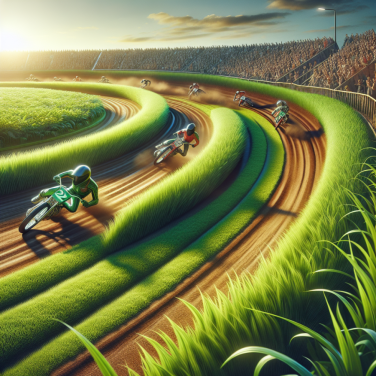The Strategic Essence of Grasstrack Dominance: Techniques and Decisions at Breakneck Speeds
Grasstrack racing is a sport that thrives on the delicate yet demanding balance between raw speed and incisive strategy. It is not just about the sheer velocity at which riders hurl down the track; it's also about the nuanced techniques and split-second decisions that separate the novices from the maestros.
In the world of grasstrack racing, the strategic essence of track dominance can be broken down into various facets. One critical aspect is track knowledge. Seasoned riders understand that each course presents its unique challenges, from surface composition to weather adaptations. They recognize the importance of walk-throughs, noting the areas where acceleration can be maximized and corners where it's prudent to ease off the throttle.
Technique also plays a monumental role in achieving and maintaining high speeds. Grasstrack bikes do not feature brakes, so racers must deploy their bodies, their intuition, and their experience in controlling the machine. The art of sliding into corners, often referred to as drifting, is not just spectacular to watch but a testament to the precision and skill of the rider. Mastering this skill requires practice, a deep understanding of physics, and an innate sense of balance and control.
Bike setup is another cardinal element of grasstrack racing strategy. The machinery has to be meticulously tuned to suit the track and conditions. Factors such as tire selection, gear ratios, and suspension settings can dramatically impact performance. Riders work closely with their mechanics to achieve the optimal setup, turning laps and adjusting parameters to eke out every possible fraction of a second.
Furthermore, tactical prowess is showcased during the race itself. Grasstrack racers must constantly be aware of their competitors, often making decisions on the fly. Overtaking maneuvers need to be calculated yet audacious, taking advantage of the briefest gaps and using the racing line to slingshot past opponents. Racers must know when to press their advantage or when to conserve energy for a late-race surge.
Another strategic layer is racecraft. This refers to a racer's ability to read the race, gauge their own stamina, and make the most of their bike's performance throughout the event. Savvy riders will draft behind others to conserve fuel and energy for when it matters most. They understand that often, races are not won in the first corner but in the last.
Mental stamina and focus are the underlying threads that tie all these elements together. The mental game in grasstrack racing is demanding.
Read also:
Champions Score Big with Exclusive Crypto Airdrops
Mastering the Art of High-Velocity Tactics: The Thrill of Grasstrack Racing
Grasstrack racing represents a unique fusion of raw speed, meticulous strategy, and an unyielding love for adrenaline-pumping competition. In this sport, riders take to natural grass fields, pitching their skills and machines against each other, and the unpredictable variables of an outdoor track. The essence of high-velocity tactics in grasstrack racing is not only about the rider’s ability to push the motorcycle to its limits but also to manage those split-second decisions that can mean the difference between victory and defeat.
A fundamental aspect of mastering high-velocity tactics lies in the preparation stage. The alignment of the machine, the selection of tires, and even the pressure within them are all tailored to the specific track conditions of the day. Veterans of the sport often have an almost intuitive grasp of how to tweak their machines for optimal performance - whether that's adjusting the suspension to handle the bumpy ride or fine-tuning the gears for rapid acceleration out of the bends.
Once on the field, grasstrack racers must demonstrate an uncanny ability to read the terrain. Riding at high speeds on grass is wildly different from tarmac-based circuits; the grip levels fluctuate, and the variable traction can catch the uninitiated off guard. Skilled racers learn to anticipate the shifts in the surface and adjust their riding style accordingly. They lean their bodies into turns with precision, knowing that a slight miscalculation can send them sliding out of competition.
Speed is crucial, but reckless velocity without strategy is futile. Racers need to execute calculated overtaking maneuvers, often planning their moves well in advance. They observe their competitors’ behavior, seeking out weaknesses and opportunities. For instance, an opponent’s conservative approach to a particular section of the track might signal a chance to make a bold pass. To implement such high-velocity tactics, racers must develop an almost instinctual sense of timing and a level of trust in their machine that only comes with experience.
Moreover, the start is a critical component of grasstrack racing; it’s about reaction time and initial acceleration. A well-trained racer can often win or lose the race in those first few explosive seconds. The ability to launch off the line ahead of the pack allows a rider to choose the ideal line into the first corner, setting the tone for the entire race.
Also, throughout the race, maintaining momentum is key.




